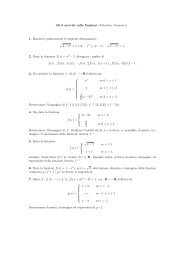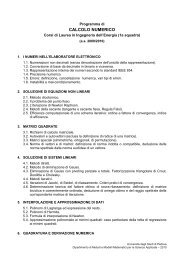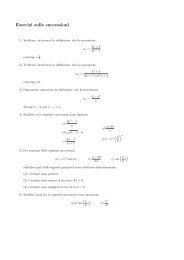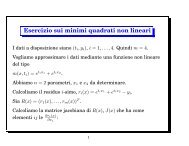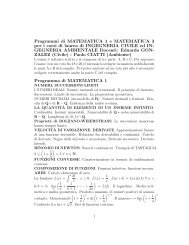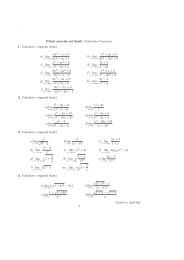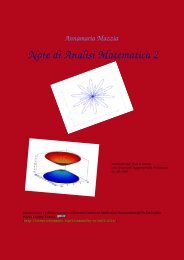Appunti di Calcolo Numerico - Esercizi e Dispense - Università degli ...
Appunti di Calcolo Numerico - Esercizi e Dispense - Università degli ...
Appunti di Calcolo Numerico - Esercizi e Dispense - Università degli ...
Create successful ePaper yourself
Turn your PDF publications into a flip-book with our unique Google optimized e-Paper software.
12.9. Applicazioni <strong>di</strong> MATLAB® nel <strong>Calcolo</strong> <strong>Numerico</strong><br />
’i vettori x e y non hanno la stessa lunghezza’)<br />
else<br />
xval=xval ( : ) ;<br />
yval=zeros ( length ( xval ) , 1 ) ; % s i crea un v e t t o r e <strong>di</strong> t u t t i zero<br />
n=length ( x ) −1; % n grado del polinomio<br />
for i =1:n+1<br />
yval = yval + lagrange ( xval , x , i ) * y ( i ) ;<br />
end<br />
end<br />
function yval=interplagrange ( xval , x , y )<br />
% dati i v e t t o r i x e y da interpolare<br />
% la function fa l ’ interpolazione <strong>di</strong> Lagrange valutandola<br />
% in xval<br />
i f length ( x)~= length ( y )<br />
error (’MATLAB:lagrange’ ,’x e y non hanno la stessa lunghezza’)<br />
else<br />
y=y ( : )<br />
n=length ( x ) −1;% n grado del polinomio<br />
A = [ ] ;<br />
for i =1:n+1<br />
A=[A , lagrange ( xval , x , i ) ] %ogni colonna della matrice A ha i l<br />
% valore dell ’ i−simo polinomio <strong>di</strong><br />
% Lagrange c a l c o l a t o nei v a l o r i xval<br />
end<br />
yval=A* y ;<br />
end<br />
Eseguiamo l’esempio <strong>di</strong> prima per vedere cosa si ottiene:<br />
>> yy=interplagrange(xx,x,y);<br />
>> plot(x,y,’o’, xx,yy)<br />
Ora la function interplagrange sostituisce l’uso delle due function polyfit, polyval o<br />
interpmonom, polyval.<br />
Calcoliamo ora il polinomio <strong>di</strong> interpolazione me<strong>di</strong>ate le <strong>di</strong>fferenze <strong>di</strong>vise <strong>di</strong> Newton. Scriviamo due<br />
functions, la prima che scrive la tabella delle <strong>di</strong>fferenze <strong>di</strong>vise, la seconda che valuta il polinomio <strong>di</strong> interpolazione<br />
implementando l’algoritmo <strong>di</strong> Horner 2 in modo da minimizzare il numero delle operazioni da<br />
eseguire.<br />
function table= d i v d i f ( x , y )<br />
% function table=<strong>di</strong>v<strong>di</strong>f ( x , y )<br />
% x − a s c i s s e dei dati da interpolare<br />
% y − or<strong>di</strong>nate dei dati da interpolare<br />
% table − t a b e l l a d e l l e d i f f e r e n z e d i v i s e<br />
x=x ( : ) ;<br />
y=y ( : ) ;<br />
n=length ( x ) ;<br />
m=length ( x ) ;<br />
i f n~=m<br />
error (’MATLAB:<strong>di</strong>fferenze_<strong>di</strong>vise’ ,’errore sui dati’)<br />
else<br />
table=zeros (n , n ) ; % iniziamo la t a b e l l a come una matrice <strong>di</strong> z e r i<br />
table ( : , 1 ) = y ;<br />
for j =2:n<br />
2 William Horner (1786-1837) fu un matematico inglese, ricordato essenzialmente per il suo metodo sulle equazioni algebriche.<br />
Spieghiamo l’algoritmo solo per rendere comprensibile la function che scriviamo.<br />
199



